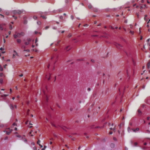Outlook for Practice
Dr. Buch and her co-investigators plan to validate this study through a larger trial to investigate if etanercept plus methotrexate has a greater benefit over standard initial methotrexate and/or additional csDMARD treatment. Additionally, they are conducting parallel experimental genomic, transcriptomic and proteomic work on bio-samples collected from study participants to further understand the mechanisms identified in these most recent findings.
Through this additional investigation, Dr. Buch suggests longer follow-up and time points could provide a high-resolution assessment of the relationship between the trajectories of disease activity and cardiac MRI abnormalities, and could introduce a study approach in which patients are stratified based on CVD risk.
If applied in practice at diagnosis, this approach would better inform treatment choice, including whether targeted therapy with a TNFi such as etanercept, may be indicated in some patients, Dr. Buch explains.
On sharing these findings at the Annual Meeting, Dr. Buch says the discussion centered on how the rheumatology community is at risk of dismissing the importance of CVD comorbidity by suggesting it has been fully addressed with improved diagnosis and more effective therapies. “Our ambition should be to refine practice, and with a more cost-effective biologic drug landscape, this could be more viable.”
Carina Stanton is a freelance science journalist based in Denver.
References
- Buch MH, Erhayiem B, Fent G, et al. Treatment-naïve, early rheumatoid arthritis patients demonstrate reversible abnormalities of vascular function on vardiac MRI with RA therapy with preliminary suggestion of greater improvement with anti-TNF compared to MTX/conventional therapy—a first, RCT derived longitudinal study [abstract]. Arthritis Rheumatol. 2018 Oct;70(suppl 10).
- Erhayiem B, Pavitt S, Baxter P, et al. Coronary Artery Disease Evaluation in Rheumatoid Arthritis (CADERA): Study protocol for a randomized controlled trial. Trials. 2014 Nov 8;15:436.
- Erhayiem B, McDiarmid A, Swoboda P, et al. Treatment-naïve, early rheumatoid arthritis patients demonstrate abnormalities of vascular and myocardial function on cardiac MRI [abstract]. Arthritis Rheumatol. 2015 Oct; 67 (suppl 10).


